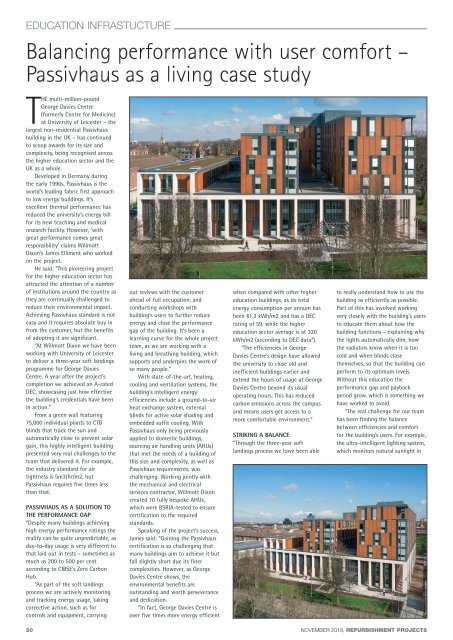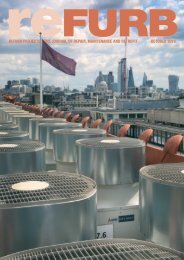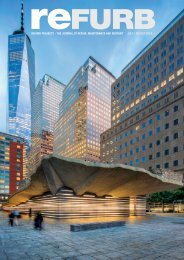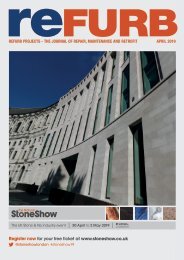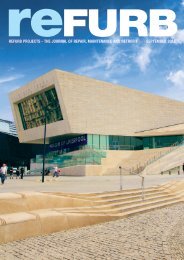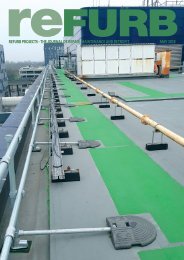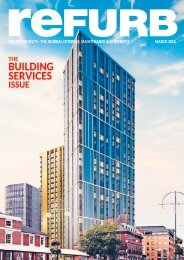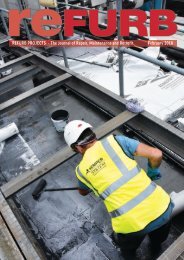Refurb Projects - November 2018
Refurb Projects launched in 1987 to cater for the expanding Repair, Maintenance, Improvement and Refurb sectors of the UK Building Industry. This represents a massive market, with refurbishment in the Health, Leisure, Education and Social Housing sectors expecting to be the mainstay of the industry for the foreseeable future. Sustainability and the protection of the built environment are essential ingredients of the refurbishment market, and Refurb Projects Journal is a leader in reporting and promoting these ideals.
Refurb Projects launched in 1987 to cater for the expanding Repair, Maintenance, Improvement and Refurb sectors of the UK Building Industry. This represents a massive market, with refurbishment in the Health, Leisure, Education and Social Housing sectors expecting to be the mainstay of the industry for the foreseeable future. Sustainability and the protection of the built environment are essential ingredients of the refurbishment market, and Refurb Projects Journal is a leader in reporting and promoting these ideals.
You also want an ePaper? Increase the reach of your titles
YUMPU automatically turns print PDFs into web optimized ePapers that Google loves.
EDUCATION INFRASTUCTURE<br />
Balancing performance with user comfort –<br />
Passivhaus as a living case study<br />
THE multi-million-pound<br />
George Davies Centre<br />
(formerly Centre for Medicine)<br />
at University of Leicester – the<br />
largest non-residential Passivhaus<br />
building in the UK – has continued<br />
to scoop awards for its size and<br />
complexity, being recognised across<br />
the higher education sector and the<br />
UK as a whole.<br />
Developed in Germany during<br />
the early 1990s, Passivhaus is the<br />
world’s leading fabric first approach<br />
to low energy buildings. It’s<br />
excellent thermal performance has<br />
reduced the university’s energy bill<br />
for its new teaching and medical<br />
research facility. However, ‘with<br />
great performance comes great<br />
responsibility’ claims Willmott<br />
Dixon’s James Elliment who worked<br />
on the project.<br />
He said: “This pioneering project<br />
for the higher education sector has<br />
attracted the attention of a number<br />
of institutions around the country as<br />
they are continually challenged to<br />
reduce their environmental impact.<br />
Achieving Passivhaus standard is not<br />
easy and it requires absolute buy in<br />
from the customer, but the benefits<br />
of adopting it are significant.<br />
“At Willmott Dixon we have been<br />
working with University of Leicester<br />
to deliver a three-year soft landings<br />
programme for George Davies<br />
Centre. A year after the project’s<br />
completion we achieved an A-rated<br />
DEC, showcasing just how effective<br />
the building’s credentials have been<br />
in action.”<br />
From a green wall featuring<br />
75,000 individual plants to CTB<br />
blinds that track the sun and<br />
automatically close to prevent solar<br />
gain, this highly intelligent building<br />
presented very real challenges to the<br />
team that delivered it. For example,<br />
the industry standard for air<br />
tightness is 5m3/hr/m2, but<br />
Passivhaus requires five times less<br />
than that.<br />
PASSIVHAUS AS A SOLUTION TO<br />
THE PERFORMANCE GAP<br />
“Despite many buildings achieving<br />
high energy performance ratings the<br />
reality can be quite unpredictable, as<br />
day-to-day usage is very different to<br />
that laid out in tests – sometimes as<br />
much as 200 to 500 per cent<br />
according to CIBSE’s Zero Carbon<br />
Hub.<br />
“As part of the soft landings<br />
process we are actively monitoring<br />
and tracking energy usage, taking<br />
corrective action, such as for<br />
controls and equipment, carrying<br />
out reviews with the customer<br />
ahead of full occupation, and<br />
conducting workshops with<br />
building’s users to further reduce<br />
energy and close the performance<br />
gap of the building. It’s been a<br />
learning curve for the whole project<br />
team, as we are working with a<br />
living and breathing building, which<br />
supports and underpins the work of<br />
so many people.”<br />
With state-of-the-art, heating,<br />
cooling and ventilation systems, the<br />
building’s intelligent energy<br />
efficiencies include a ground-to-air<br />
heat exchange system, external<br />
blinds for active solar shading and<br />
embedded soffit cooling. With<br />
Passivhaus only being previously<br />
applied to domestic buildings,<br />
sourcing air handling units (AHUs)<br />
that met the needs of a building of<br />
this size and complexity, as well as<br />
Passivhaus requirements, was<br />
challenging. Working jointly with<br />
the mechanical and electrical<br />
services contractor, Willmott Dixon<br />
created 10 fully bespoke AHUs,<br />
which were BSRIA-tested to ensure<br />
certification to the required<br />
standards.<br />
Speaking of the project’s success,<br />
James said: “Gaining the Passivhaus<br />
certification is so challenging that<br />
many buildings aim to achieve it but<br />
fall slightly short due its finer<br />
complexities. However, as George<br />
Davies Centre shows, the<br />
environmental benefits are<br />
outstanding and worth perseverance<br />
and dedication.<br />
“In fact, George Davies Centre is<br />
over five times more energy efficient<br />
when compared with other higher<br />
education buildings, as its total<br />
energy consumption per annum has<br />
been 61.2 kWh/m2 and has a DEC<br />
rating of 59, while the higher<br />
education sector average is at 320<br />
kWh/m2 (according to DEC data*).<br />
“The efficiencies in George<br />
Davies Centre’s design have allowed<br />
the university to close old and<br />
inefficient buildings earlier and<br />
extend the hours of usage at George<br />
Davies Centre beyond its usual<br />
operating hours. This has reduced<br />
carbon emissions across the campus<br />
and means users get access to a<br />
more comfortable environment.”<br />
STRIKING A BALANCE<br />
“Through the three-year soft<br />
landings process we have been able<br />
to really understand how to use the<br />
building as efficiently as possible.<br />
Part of this has involved working<br />
very closely with the building’s users<br />
to educate them about how the<br />
building functions – explaining why<br />
the lights automatically dim, how<br />
the radiators know when it is too<br />
cold and when blinds close<br />
themselves, so that the building can<br />
perform to its optimum levels.<br />
Without this education the<br />
performance gap and payback<br />
period grow, which is something we<br />
have worked to avoid.<br />
“The real challenge for our team<br />
has been finding the balance<br />
between efficiencies and comfort<br />
for the building’s users. For example,<br />
the ultra-intelligent lighting system,<br />
which monitors natural sunlight in<br />
20 NOVEMBER <strong>2018</strong>, REFURBISHMENT PROJECTS


